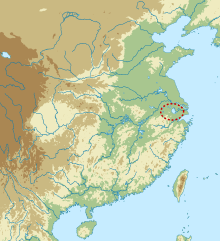Songze culture
The Songze Culture was a Neolithic culture that existed between 3800 and 3300 BCE in the Lake Tai area near Shanghai.[1][2]
 | |||||||
| Geographical range | Eastern China | ||||||
|---|---|---|---|---|---|---|---|
| Period | Neolithic China | ||||||
| Dates | c. 3800 – c. 3300 BCE | ||||||
| Preceded by | Majiabang culture | ||||||
| Followed by | Liangzhu culture | ||||||
| Chinese name | |||||||
| Traditional Chinese | 崧澤文化 | ||||||
| Simplified Chinese | 崧泽文化 | ||||||
| |||||||
_-_DSCN8233BB.jpg)
Dates
Three radiocarbon dates were taken from Songze culture layers at Jiangli near Lake Tai. Two of the dates were obtained from charred rice grains, returning dates of 3360–3090 BCE and 3540–3370 BCE. The third date was taken from knotgrass and produced a date of 3660–3620 BCE.[3] Although it is accepted to be the successor of the Majiabang culture, others have suggested that Songze was a successor phase to the Hemudu culture.[4]
Sites
Songze
In 1957, archaeologists discovered a site north of Songze Village near Zhaoxiang Town Chinese: 赵巷镇 in Shanghai's Qingpu District.[5] Excavations have been conducted throughout 1961, 1974–1976, 1987, 1994–1995, and 2004. These revealed three cultural layers: the most recent had pottery from the Spring and Autumn period; the middle layer was a cemetery with 148 graves and numerous artefacts; the oldest layer belonged to a village of the Majiabang culture.[5]
Nanhebang
92 graves have been excavated from a Songze cemetery at Nanhebang.[6]
Pishan
The Pishan cemetery contained 61 burials.[6]
Dongshan
Dongshan Village is located near Jingang Town 18 km west of Zhangjiagang. It was discovered in 1989 and has undergone excavations by the Suzhou Museum (1989–1990), followed by two large rescue excavations led by the Nanjing Museum in 2008–2009.[7] The site is divided into three areas: area 1 was a small cemetery of 27 burials, all of which had different quantities of grave goods, which has been used to suggest the existence of a stratified society; area 2 was a residential comprising five buildings in the centre of the site; area 3 was another burial ground in the site's west, with 10 tombs.[7]
Notes
- Wang (2001), p. 220.
- Qin (2013), p. 578.
- Qiu et al. (2014).
- Goodenough (1993), p. 45.
- Shanghai Qingpu Museum (2014).
- Li (2012), p. 134.
- Li (2012), p. 135.
References
- Goodenough, Ward Hunt (1996). Prehistoric Settlement of the Pacific, Volume 86, Part 5. American Philosophical Society.
- Li, Boqian (2012). "Implications of Large Burial Sites of Songze Culture". Social Sciences in China. 33 (2): 133–141. doi:10.1080/02529203.2012.677283.
- Qin, Ling (2013), "The Liangzhu culture", in Underhill, Anne P. (ed.), A Companion to Chinese Archaeology, John Wiley & Sons, pp. 574–596, ISBN 978-1-118-32572-8.
- Qiu, Zhenwei; Jiang, Hongen; Ding, Jinlong; Hu, Yaowu; Shang, Xue (2014), "Pollen and Phytolith Evidence for Rice Cultivation and Vegetation Change during the Mid-Late Holocene at the Jiangli Site, Suzhou, East China", PLOS ONE, 9 (1): e86816, doi:10.1371/journal.pone.0086816, PMC 3900649
- Wang, Haiming (2001), "Majiabang", in Peregrine, Peter N.; Ember, Martin (eds.), Encyclopedia of Prehistory, Volume 3: East Asia and Oceania, Springer, pp. 206–221, ISBN 978-0-306-46257-3.
- Shanghai Qingpu Museum (ed.). "The Songze Culture Site". Shanghai Qingpu Museum. Retrieved 21 November 2014.